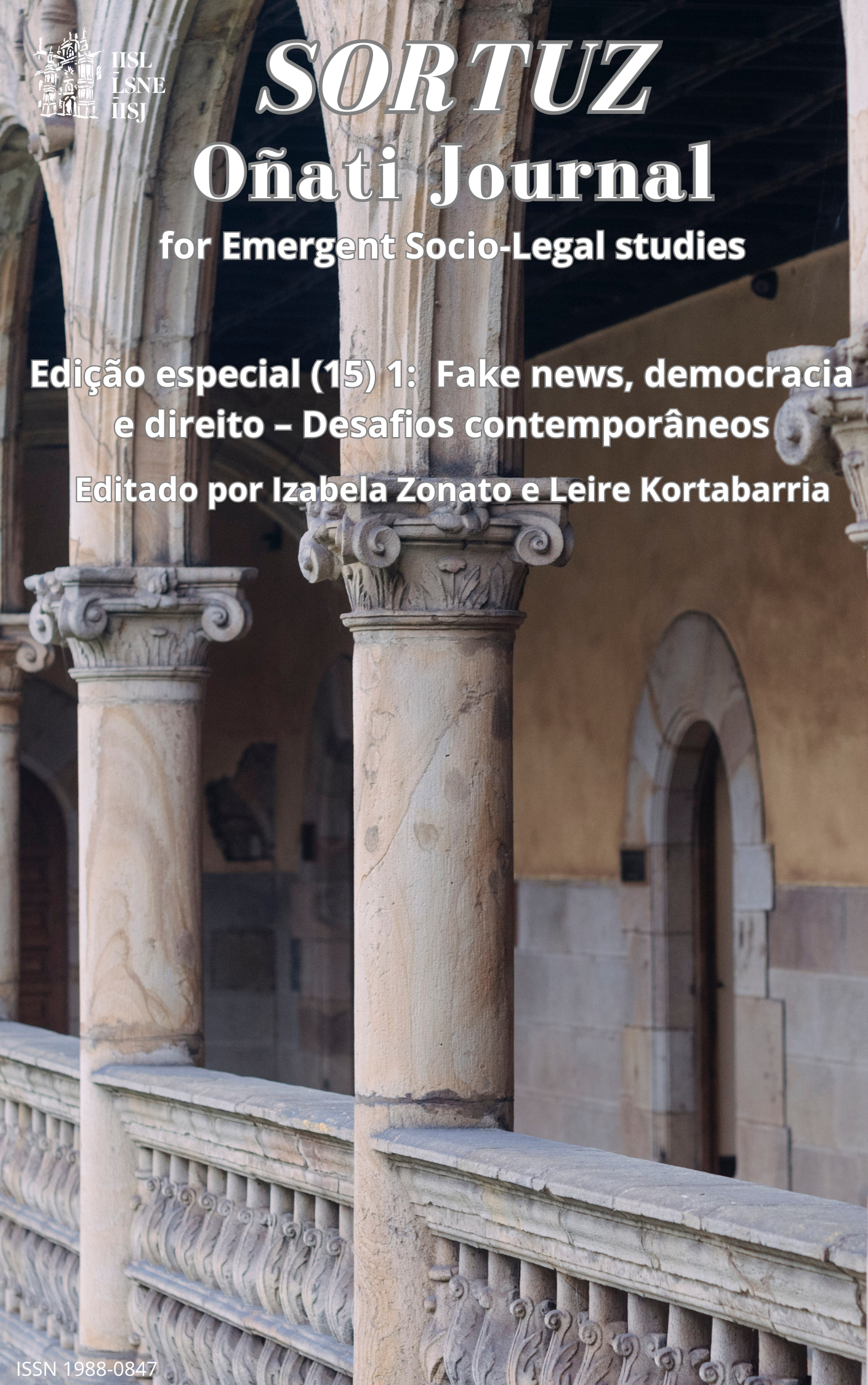Judicial perceptions on working time
Examining quality and intensity of work in Portuguese first instance courts
DOI:
https://doi.org/10.35295/sz.iisl/2011Palavras-chave:
first instance judges, working time, intensity, working conditionsResumo
Judicial systems across different jurisdictions and regions of the world have, in recent years, been subject to judicial reforms that have reconfigured the way judges work. Although they are not considered to be typical workers and studies on judges' working conditions are not very common, the few studies that do exist point to widespread dissatisfaction among judges with their working time, which is characterized by a fast pace of work and permanent work outside of conventional working hours, a result of the high volume of cases and the need to meet procedural deadlines. This article aims to look at working time quality and intensity of judges based on the perceptions of Portuguese judges working in first instance courts, in general and specialised courts, collected through a survey. The results point to differences in the perceptions of working intensity and quality between judges from general and specialised courts, as well as individual sociodemographic characteristics, such as gender, age and years of service.
Downloads
Estatísticas globais ℹ️
|
319
Visualizações
|
154
Downloads
|
|
473
Total
|
|
Referências
Adăscăliței, D., Heyes, J., and Mendonça, P., 2022. The intensification of work in Europe: A multilevel analysis. British Journal of Industrial Relations [online], 60(2), 324–347. Available at: https://doi.org/10.1111/bjir.12611 DOI: https://doi.org/10.1111/bjir.12611
Avgoustaki, A., 2016. Work uncertainty and extensive work effort: the mediating role of human resource practices. Industrial and Labor Relations Review [online], 69(3), 656–682. Available at: https://doi.org/10.1177/0019793915614584 DOI: https://doi.org/10.1177/0019793915614584
Blackham, A., 2019. Reconceiving Judicial Office Through a Labour Law Lens. Federal Law Review [online], 47(2), 203–230. Available at: https://doi.org/10.1177/0067205X19831826 DOI: https://doi.org/10.1177/0067205X19831826
Branco, P., 2015. Análise da arquitetura judiciária portuguesa: as dimensões de reconhecimento, funcionalidade e acesso à justiça. E-Cadernos CES [online], 23. Available at: https://doi.org/10.4000/eces.1930 DOI: https://doi.org/10.4000/eces.1930
Casaleiro, P., et al., 2019. Condições de trabalho e qualidade de trabalho: reflexões para um estudo das profissões judiciais. International Journal of Working Conditions [online], 18, 84–97. Available at: https://ricot.com.pt/artigos/1/IJWC.18_Casaleiro%20et%20al._p.83.97.pdf
Chamberlain, J., and Miller, M.K., 2008. Stress in the Courtroom: Call for research. Psychiatry Psychology and Law [online], 15(2), 237–250. Available at: https://doi.org/10.1080/13218710802014485 DOI: https://doi.org/10.1080/13218710802014485
Chase, D., and Hora, P.F., 2009. The best seat in the house: The court assignment and judicial satisfaction. Family Court Review [online], 47(2), 209–238. Available at: https://doi.org/10.1111/j.1744-1617.2009.01250.x DOI: https://doi.org/10.1111/j.1744-1617.2009.01250.x
Cid Teles, M., 2023. O Tempo de Trabalho da Magistratura Judicial: Estudo comparativo dos tribunais de primeira instância de competência genérica e especializada [online]. Master’s thesis. University of Coimbra. Available at: https://estudogeral.uc.pt/handle/10316/112960
Cura, A.V., 2015. A especialização dos tribunais judiciais (ou das suas secções) na lei da organização do sistema judiciário e no diploma que a regulamenta. Julgar [online], 27, 95–115. Available at: https://julgar.pt/a-especializacao-dos-tribunais-judiciais-ou-das-suas-seccoes-na-lei-da-organizacao-do-sistema-judiciario-e-no-diploma-que-a-regulamenta/
Duarte, M., et al., 2014. The Feminization of the Judiciary in Portugal: Dilemmas and Paradoxes. Utrecht Law Review [online], 10(1), 29-43. Available at: https://doi.org/10.18352/ulr.255 DOI: https://doi.org/10.18352/ulr.255
Eells, T., and Showalter, R., 1994. Work-related stress in American trial judges. Bulletin of the American Academy of Psychiatry & the Law [online], 22(1), 71–83. Available at: https://pubmed.ncbi.nlm.nih.gov/8193391/
Eurofound, 2017. Sixth European Working Conditions Survey - Overview report (2017 update). Luxembourg: Publications Office of the European Union.
Ferreira, A.C., et al., 2014. Quem são os nossos magistrados? Caracterização profissional dos juízes e magistrados do Ministério Público em Portugal [online]. Coimbra: Estudo Geral Repositório científico da UC. Available at: https://hdl.handle.net/10316/86801
Flores, D., et al., 2009. Judges’ Perspectives on Stress and Safety in the Courtroom: An Exploratory Study. Court Review: The Journal of the American Judges Association, 45(3), 76–89.
Fonseca, B., 2017. Riscos Psicossociais e engagement nos magistrados do Ministério Público: Uma relação moderada pelo capital psicológico [online]. Porto: Universidade Católica Portuguesa. Available at: https://repositorio.ucp.pt/bitstream/10400.14/22889/1/201759322.pdf
Garoupa, N., Jorgensen, N., and Vazquez, P., 2010. Assessing the argument for specialized courts: Evidence from family courts in Spain. International Journal of Law, Policy and the Family [online], 24(1), 54–66. Available at: https://doi.org/10.1093/lawfam/ebp012 DOI: https://doi.org/10.1093/lawfam/ebp012
Gomes, C., 2015. Justiça e eficiência: o debate e os desafios à gestão dos tribunais. Cronos [online], 16(2), 8–23. Available at: https://periodicos.ufrn.br/cronos/article/view/11476
Green, F., 1999. It’s Been a Hard Day’s Night: The Concentration and Intensification of Work in Late Twentieth-Century Britain. British Journal of Industrial Relations [online], 39(1), 53-80. Available at: https://doi.org/10.1111/1467-8543.00189 DOI: https://doi.org/10.1111/1467-8543.00189
Green, F., et al., 2022. Working Still Harder. ILR Review [online], 75(2), 458–487. Available at: https://doi.org/10.1177/0019793920977850 DOI: https://doi.org/10.1177/0019793920977850
Hakanen, J., Rodriguez-Sanchez, A.M., and Perhoniemi, R., 2012. Too good to be true? Similarities and differences between engagement and workaholism among Finnish judges. Ciencia & Trabajo, 14, 72–80.
International Bar Association, 2021. Mental Wellbeing in the Legal Profession: A Global Study [online]. London: IBA Presidential Task Force. Available at: https://www.ibanet.org/document?id=IBA-report-Mental-Wellbeing-in-the-Legal-Profession-A-Global-Study
Jaffe, P.G., et al., 2003. Vicarious Trauma in Judges: The Personal Challenge of Dispensing Justice. Juvenile and Family Court Journal [online], 54(4), 1-9. Available at: https://doi.org/10.1111/j.1755-6988.2003.tb00083.x DOI: https://doi.org/10.1111/j.1755-6988.2003.tb00083.x
Lipp, M., and Tanganelli, M.S., 2002. Stress e Qualidade de Vida em Magistrados da Justiça do Trabalho: Diferenças entre Homens e Mulheres. Psicologia: Reflexão e Crítica [online], 15(3), 537–548. Available at: https://doi.org/10.1590/S0102-79722002000300008 DOI: https://doi.org/10.1590/S0102-79722002000300008
Ludewig, R., and Lallave, J., 2014. Professional Stress, Discrimination and Coping Strategies: Similarities and Differences between Female and Male Judges in Switzerland. In: U. Schultz and G. Shaw, eds., Gender and Judging. Oxford: Hart, 233–252.
Lustig, S., et al., 2008a. Burnout and Stress Among United States Immigration Judges. Bender’s Immigration Bulletin [online], 13, 22–30. Available at: https://www.naij-usa.org/images/uploads/publications/Burnout-and-Stress-Among-United-States-Immigration-Judges_01-01-08_1.pdf
Lustig, S., et al., 2008b. Inside the Judges’ Chambers: Narrative Responses from the National Association of Immigration Judges Stress and Burnout Survey. The Georgetown Immigration Law Journal, 23(57), 57–83.
Mack, K., Anleu, S., and Wallace, A., 2011. Everyday work in the magistrates’ courts: Time and tasks. Journal of Judicial Administration [online], 21(1), 34–53. Available at: https://ssrn.com/abstract=2623438
Mak, E., 2008. Balancing Territoriality and Functionality; Specialization as a Tool for Reforming Jurisdiction in the Netherlands, France and Germany. International Journal for Court Administration [online], 1(2), 2–9. Available at: https://doi.org/10.18352/ijca.97 DOI: https://doi.org/10.18352/ijca.97
Miller, M.K., et al., 2018. Judicial stress: the roles of gender and social support. Psychiatry, Psychology and Law [online], 25(4), 602–618. Available at: https://doi.org/10.1080/13218719.2018.1469436 DOI: https://doi.org/10.1080/13218719.2018.1469436
Miller, M.K., Flores, D., and Pitcher, B., 2010. Using constructivist self-development theory to understand judges’ reactions to a courthouse shooting: An exploratory study. Psychiatry, Psychology and Law, 17(1), 121–138. Available at: https://doi.org/10.1080/13218710902930309 DOI: https://doi.org/10.1080/13218710902930309
Na, C., Choo, T., and Klingfuss, J.A., 2018. The Causes and Consequences of Job-Related Stress among Prosecutors. American Journal of Criminal Justice [online], 43(2), 329–353. Available at: https://doi.org/10.1007/s12103-017-9396-4 DOI: https://doi.org/10.1007/s12103-017-9396-4
Roach Anleu, S., and Mack, K., 2009. Gender, Judging and Job Satisfaction. Feminist Legal Studies [online], 17, 79–99. Available at: https://doi.org/10.1007/s10691-009-9111-z DOI: https://doi.org/10.1007/s10691-009-9111-z
Roach Anleu, S., and Mack, K., 2016. Managing Work and Family in the Judiciary: Metaphors and Strategies. Flinders Law Journal [online], 18(2), 213-239. Available at: http://classic.austlii.edu.au/au/journals/FlinLawJl/2016/8.pdf
Roach Anleu, S., Mack, K. 2014. Judicial Performance and Experiences of Judicial Work. Oñati Socio-Legal Series [online], 4(5), 1015-1040. Available at: https://opo.iisj.net/index.php/osls/article/view/300
Rogers, J.M., Freeman, S.J.J., and Lesage, P., 1991. The Occupational Stress of Judges. The Canadian Journal of Psychiatry [online], 36(5), 317–322. Available at: https://doi.org/10.1177/070674379103600501 DOI: https://doi.org/10.1177/070674379103600501
Rossouw, E., and Rothmann, S., 2020. Well-being of judges: A review of quantitative and qualitative studies. SA Journal of Industrial Psychology [online], 46, 1–12. Available at: https://doi.org/10.4102/sajip.v46i0.1759 DOI: https://doi.org/10.4102/sajip.v46i0.1759
Ryan, J.P., et al., 1980. American Trial Judges: Their Work Styles and Performance. New York: Free Press.
Tsai, F.J., and Chan, C.C., 2010. Occupational stress and burnout of judges and procurators. International Archives of Occupational and Environmental Health [online], 83(2), 133–142. Available at: https://doi.org/10.1007/s00420-009-0454-1 DOI: https://doi.org/10.1007/s00420-009-0454-1
Wallace, J.E., 1995. Corporatist Control and Organizational Commitment among Professionals: The Case of Lawyers Working in Law Firms. Social Forces [online], 73(3), 811-840. Available at: https://doi.org/10.2307/2580548 DOI: https://doi.org/10.2307/2580548
Wallace, J.E., 1997. It’s about Time: A Study of Hours Worked and Work Spillover among Law Firm Lawyers. Journal of Vocational Behavior [online], 50(2), 227–248. Available at: https://doi.org/10.1006/jvbe.1996.1573 DOI: https://doi.org/10.1006/jvbe.1996.1573
Zimmerman, I.M., 1981. Stress: what it does to judges and how it can be lessened. Judges’ Journal, 20(3), 18–22.
Downloads
Publicado
Como Citar
Edição
Seção
Licença
Copyright (c) 2025 Madalena Cid Teles, Paula Casaleiro

Este trabalho está licenciado sob uma licença Creative Commons Attribution 4.0 International License.
Sortuz: Oñati Journal of Emergent Socio-Legal Studies provides immediate open access to all its content on the principle that making research freely available to the public supports a greater global exchange of knowledge.
All articles are published under a Creative Commons Attribution 4.0 International License.
Copyright and publishing rights are held by the authors of the articles. We do, however, kindly ask for later publications to indicate Sortuz as the original source.

















